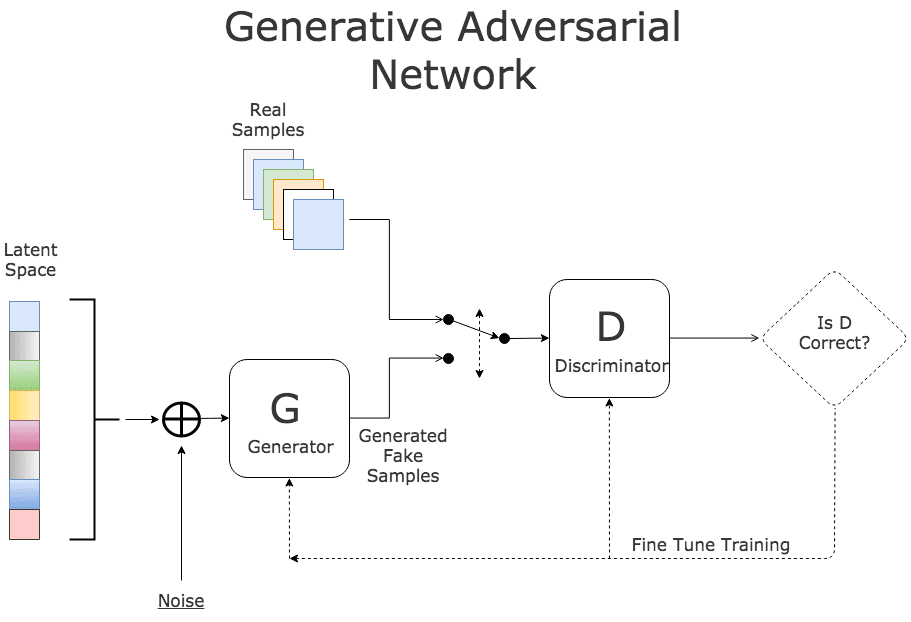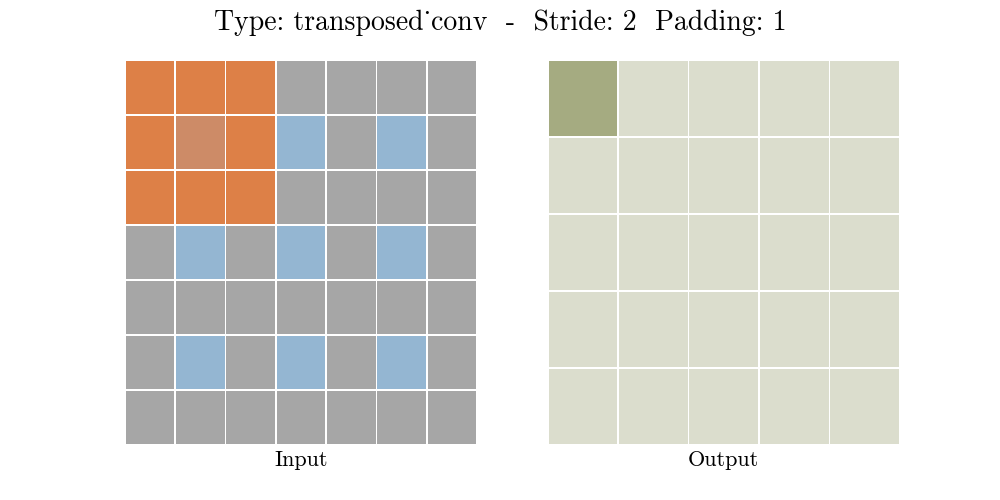Anime Image Generation using GANS - Pytorch
Introduction to Generative Modeling
Generative Adversarial Networks (GANs) use neural network for generative modeling, It is an unsupervised learning task in machine learning that involves automatically discovering and learning the ragularities or patterns in input data in such a way that the model can be used to generate or output new examples that plausibly could have been drawn from the original dataset ex:- thispersondoesnotexist.com

HOW this works bruh :
GAN have two different neural networks, Generator network(takes input a random vector and it generates an image) and Discriminator network(model whose job is to diffrentiate between real images which are drawn from dataset and generated images)
WAY the training works :
we train Discriminator on batches of both Real and Generated images so it should be good at discriminating, we then use discriminator as a part of the loss function of the Generator we take a generated image from the generator we pass them through the discriminator and we try to fool the discriminator, then update the generator.
Generator tries to fool and Discriminator tries to catch the bluff

GANs are difficult to train and are extremely sensitive to hyperparameters, activation function and regularisation
More Resources: off convex blog, GANs and Divergence Minimization
Dataset : Anime Face Dataset --> https://www.kaggle.com/splcher/animefacedataset
project_name = 'anime-dcgan'
Download and Explore the dataset using opendatasets library import opendatasets as od dataset_url = 'https://www.kaggle.com/splcher/animefacedataset' od.download(dataset_url)
import os
DATA_DIR = "./animefacedataset"
print(os.listdir(DATA_DIR))
print(os.listdir(DATA_DIR + "/images")[:10])
from torch.utils.data import DataLoader
from torchvision.datasets import ImageFolder
import torchvision.transforms as T
image_size = 64 # crop images to 64x64 pixels
batch_size = 128
stats = (0.5, 0.5, 0.5), (0.5, 0.5, 0.5) # normalize the pixel values with mean and std deviation of 0.5, to get pixel value in range (-1,1)
train_ds = ImageFolder(DATA_DIR, transform=T.Compose([
T.Resize(image_size),
T.CenterCrop(image_size),
T.ToTensor(),
T.Normalize(*stats)
]))
train_dl = DataLoader(train_ds,
batch_size,
shuffle=True,
num_workers=3,
pin_memory=True)
import torch
from torchvision.utils import make_grid
import matplotlib.pyplot as plt
%matplotlib inline
def denorm(img_tensors): #std=0.5 mean
return img_tensors * stats[1][0] + stats[0][0]
def show_images(images, nmax=64):
fig, ax = plt.subplots(figsize=(8, 8))
ax.set_xticks([]); ax.set_yticks([])
ax.imshow(make_grid(denorm(images.detach()[:nmax]), nrow=8).permute(1, 2, 0)) #pytorch images have color channels in the first dimension, where as matplotlib require color channels to be in the last dimension so we permute
def show_batch(dl, nmax=64):
for images, _ in dl:
show_images(images, nmax)
break
show_batch(train_dl)
def get_default_device():
if torch.cuda.is_available():
return torch.device('cuda')
else:
return torch.device('cpu')
def to_device(data, device):
if isinstance(data, (list, tuple)):
return [to_device(x, device) for x in data]
return data.to(device, non_blocking=True)
class DeviceDataLoader():
def __init__(self, dl, device):
self.dl = dl
self.device = device
def __iter__(self):
for b in self.dl:
yield to_device(b, self.device)
def __len__(self):
return len(self.dl)
device = get_default_device()
device
train_dl = DeviceDataLoader(train_dl, device)
import torch.nn as nn
discriminator = nn.Sequential(
# in: 3 x 64 x 64
nn.Conv2d(3, 64, kernel_size=4, stride=2, padding=1, bias=False),
nn.BatchNorm2d(64),
nn.LeakyReLU(0.2, inplace=True),
# out: 64 x 32 x 32
nn.Conv2d(64, 128, kernel_size=4, stride=2, padding=1, bias=False),
nn.BatchNorm2d(128),
nn.LeakyReLU(0.2, inplace=True),
# out: 128 x 16 x 16
nn.Conv2d(128, 256, kernel_size=4, stride=2, padding=1, bias=False),
nn.BatchNorm2d(256),
nn.LeakyReLU(0.2, inplace=True),
# out: 256 x 8 x 8
nn.Conv2d(256, 512, kernel_size=4, stride=2, padding=1, bias=False),
nn.BatchNorm2d(512),
nn.LeakyReLU(0.2, inplace=True),
# out: 512 x 4 x 4
nn.Conv2d(512, 1, kernel_size=4, stride=1, padding=0, bias=False),
# out: 1 x 1 x 1
nn.Flatten(),
nn.Sigmoid()
)
Because we use discriminator as a part of the loss function to train the genrator, ReLU will lead to a lot of outputs from the generator being lost, so Leaky ReLU allows the pass of a gradient signal even for the negative value, that makes the gradients from the discriminator flows stronger into the generator.
so the idea here is,none of imformation whould get lost using discriminator and gradient function to train generator
discriminator = to_device(discriminator, device)
Generator Network
input to generator is typically a vector or a matrix of random numbers (ie. latent tensor)
Generator will take a latent tensor of shape (128, 1, 1) and convert to an image tensor of shape (3 x 28 x 28)
To achive this we'll use ConvTranspose2d Layer from pytorch, which performs as a transposed convolution of deconvolution
To get a better understanding of Transposed Convolution
also read this Convolution arithmetic



latent_size = 128
generator = nn.Sequential(
# in: latent_size x 1 x 1
nn.ConvTranspose2d(latent_size, 512, kernel_size=4, stride=1, padding=0, bias=False),
nn.BatchNorm2d(512),
nn.ReLU(True),
# out: 512 x 4 x 4
nn.ConvTranspose2d(512, 256, kernel_size=4, stride=2, padding=1, bias=False),
nn.BatchNorm2d(256),
nn.ReLU(True),
# out: 256 x 8 x 8
nn.ConvTranspose2d(256, 128, kernel_size=4, stride=2, padding=1, bias=False),
nn.BatchNorm2d(128),
nn.ReLU(True),
# out: 128 x 16 x 16
nn.ConvTranspose2d(128, 64, kernel_size=4, stride=2, padding=1, bias=False),
nn.BatchNorm2d(64),
nn.ReLU(True),
# out: 64 x 32 x 32
nn.ConvTranspose2d(64, 3, kernel_size=4, stride=2, padding=1, bias=False),
nn.Tanh()
# out: 3 x 64 x 64
)
we are using tanh():

hyperbolic tangent activation function : reduces values into the range -1 to 1 --> when 3 x 64 x 64 feature map is generated from convtranspose2d its values can range between -infy to infy , so it convert them to -1 to 1 so that outputs of images are in range -1 to 1
xb = torch.randn(batch_size, latent_size, 1, 1) # random latent tensors
print(xb.shape)
fake_images = generator(xb)
print(fake_images.shape)
show_images(fake_images)
generator = to_device(generator, device)
def train_discriminator(real_images, opt_d):
# clear discriminator gradients
opt_d.zero_grad()
# Pass real images through the discriminator
real_preds = discriminator(real_images)
real_targets = torch.ones(real_images.size(0), 1, device=device)
real_loss = F.binary_cross_entropy(real_preds, real_targets)
real_score = torch.mean(real_preds).item()
# Generate fake images
latent = torch.randn(batch_size, latent_size, 1, 1, device=device)
fake_images = generator(latent)
# Pass fake images through discriminator
fake_targets = torch.zeros(fake_images.size(0), 1, device=device)
fake_preds = discriminator(fake_images)
fake_loss = F.binary_cross_entropy(fake_preds, fake_targets)
fake_score = torch.mean(fake_preds).item()
# Update discriminator weights
loss = real_loss + fake_loss
loss.backward()
opt_d.step()
return loss.item(), real_score, fake_score
Here are the steps involved in training the discriminator.
We expect the discriminator to output 1 if the image was picked from the real MNIST dataset, and 0 if it was generated using the generator network.
We first pass a batch of real images, and compute the loss, setting the target labels to 1.
Then we pass a batch of fake images (generated using the generator) pass them into the discriminator, and compute the loss, setting the target labels to 0.
Finally we add the two losses and use the overall loss to perform gradient descent to adjust the weights of the discriminator.
It's important to note that we don't change the weights of the generator model while training the discriminator (opt_d only affects the discriminator.parameters())
Generator Training
Since the outputs of the generator are images, it's not obvious how we can train the generator. This is where we employ a rather elegant trick, which is to use the discriminator as a part of the loss function.
We generate a batch of images using the generator, pass the into the discriminator.
We calculate the loss by setting the target labels to 1 i.e. real. We do this because the generator's objective is to "fool" the discriminator.
We use the loss to perform gradient descent i.e. change the weights of the generator, so it gets better at generating real-like images to "fool" the discriminator.
def train_generator(opt_g):
opt_g.zero_grad()
#generate fake images
latent = torch.randn(batch_size, latent_size, 1, 1, device=device)
fake_images = generator(latent)
#try to fool the discriminator
preds = discriminator(fake_images)
targets = torch.ones(batch_size, 1, device=device)
loss = F.binary_cross_entropy(preds, targets)
#update generator weights
loss.backward()
opt_g.step()
return loss.item()
from torchvision.utils import save_image
sample_dir = 'generated'
os.makedirs(sample_dir, exist_ok=True)
def save_sample(index, latent_tensors, show=True):
fake_images = generator(latent_tensors)
fake_fname = 'generated-images-{0:0=4d}.png'.format(index)
save_image(denorm(fake_images), os.path.join(sample_dir, fake_fname), nrow=8)
print('Saving', fake_fname)
if show:
fig, ax = plt.subplots(figsize=(8,8))
ax.set_xticks([]); ax.set_yticks([])
ax.imshow(make_grid(fake_images.cpu().detach(), nrow=8).permute(1, 2, 0))
# save one set of images before start training our model
fixed_latent = torch.randn(64, latent_size, 1, 1, device=device)
save_sample(0, fixed_latent)
Full Training Loop
Let's define a fit function to train the discriminator and generator in tandem for each batch of training data. We'll use the Adam optimizer with some custom parameters (betas) that are known to work well for GANs. We will also save some sample generated images at regular intervals for inspection.

from tqdm import tqdm
import torch.nn.functional as F
def fit(epoch, lr, start_idx=1):
torch.cuda.empty_cache()
# Losses and scores
losses_g = []
losses_d = []
real_scores = []
fake_scores = []
# create optimizers
opt_d = torch.optim.Adam(discriminator.parameters(), lr=lr, betas=(0.5, 0.999))
opt_g = torch.optim.Adam(generator.parameters(), lr=lr, betas=(0.5, 0.999))
for epoch in range(epochs):
for real_images, _ in tqdm(train_dl):
# Train discriminator
loss_d, real_score, fake_score = train_discriminator(real_images, opt_d)
# Train generator
loss_g = train_generator(opt_g)
# Record losses and scores
losses_g.append(loss_g)
losses_d.append(loss_d)
real_scores.append(real_score)
fake_scores.append(fake_score)
# log losses and scores (last batch)
print("Epoch [{}/{}], loss_g: {:.4f}, loss_d: {:.4f}, real_score: {:.4f}, fake_score: {:.4f}".format(epoch+1, epochs, loss_g, loss_d, real_score, fake_score))
save_sample(epoch+start_idx, fixed_latent, show=False)
return losses_g, losses_d, real_scores, fake_scores
lr = 0.0002
epochs = 10
history = fit(epochs, lr)
losses_g, losses_d, real_scores, fake_scores = history
torch.save(generator.state_dict(), 'Anime-Generator-state.pth')
torch.save(discriminator.state_dict(), 'Anime-Discriminator-state.pth')
from IPython.display import Image
Image('./generated/generated-images-0001.png')
Image('./generated/generated-images-0007.png')
Image('./generated/generated-images-0010.png')
import cv2
import os
vid_fname = 'gans_training.avi'
files = [os.path.join(sample_dir, f) for f in os.listdir(sample_dir) if 'generated' in f]
files.sort()
out = cv2.VideoWriter(vid_fname,cv2.VideoWriter_fourcc(*'MP4V'), 1, (530,530))
[out.write(cv2.imread(fname)) for fname in files]
out.release()
We can also visualize how the loss changes over time. Visualizing losses is quite useful for debugging the training process. For GANs, we expect the generator's loss to reduce over time, without the discriminator's loss getting too high.
plt.plot(losses_d, '-')
plt.plot(losses_g, '-')
plt.xlabel('epoch')
plt.ylabel('loss')
plt.legend(['Discriminator', 'Generator'])
plt.title('Losses');
plt.plot(real_scores, '-')
plt.plot(fake_scores, '-')
plt.xlabel('epoch')
plt.ylabel('score')
plt.legend(['Real', 'Fake'])
plt.title('Scores');


